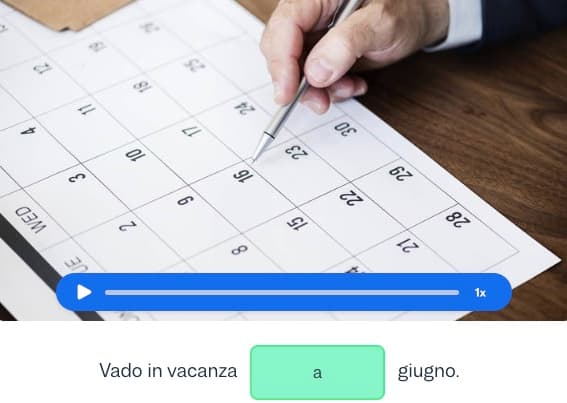I want to learn...
Prepositions are short — usually just two or three letters long — and we use them to talk about where we are, where we’re from, where we’re going and how people or things are connected. In English, our prepositions include “at”, “in”, “of”, “about”, “with”, “from”, and so on.
Today, let’s discover what these are, and how these Italian prepositions differ from English (because they can’t always be used the same way!).
Italian prepositions
In Italian, we have two kinds of prepositions: simple and articulated prepositions (preposizioni articolate). Let’s start with simple prepositions. For this lesson, we recommend reviewing Italian articles before you begin because Italian prepositions often will combine with Italian articles.
Let’s start with the eight simple prepositions or preposizioni semplici:
Prepositions in Italian
| Italian prepositions | English translation |
|---|---|
| Di | of, from, about |
| A | to, at |
| Da | from, since, by |
| In | in |
| Con | with |
| Su | on, about, above |
| Per | for |
| Tra/fra | in, between, among |
Simple enough, right? Now, let’s look at articulated prepositions.
Joining an Italian preposition with a definite article
The other kind of preposition in Italian is articulated. That just means we combine the preposition with the definite article whenever both are in the sentence.
For example:
Vado alla biblioteca della città. (I’m going to the town’s library.)a + la; di + la
In this example,bibliotecaandcittà are both feminine, so they’ll take the la definite article. We have two prepositions:a and di. A combines with lato become alla.Di joins with la to become della. Why do Italian speakers do this? It makes pronunciation smoother.
Here’s a quick breakdown chart of all Italian prepositions combined with every definite article.
Chart of articulated prepositions in Italian: Masculine
| Preposition | il | lo | i | gli |
|---|---|---|---|---|
| di (of) | del | dello | dei | degli |
| a (to/at) | al | allo | ai | agli |
| da (from/by) | dal | dallo | dai | dagli |
| in (in) | nel | nello | nei | negli |
| su (on) | sul | sullo | sui | sugli |
And now for the feminine prepositions:
Chart of articulated prepositions in Italian: Feminine
| Preposition | la | le | le |
|---|---|---|---|
| di (of) | della | delle | dell’ |
| a (to/at) | alla | alle | all’ |
| da (from/by) | dalla | dalle | dall’ |
| in (in) | nella | nelle | nell’ |
| su (on) | sulla | sulle | sull’ |
Here are some more examples of Italian articulated prepositions in action:
Entrò nel negozio. (He walked into the store.)
Vengo dalla palestra. (I am coming from the gym.)
È un dipinto sulle feste spagnole. (It’s a painting about Spanish festivals.)
And there you have it! These are all of the Italian prepositions. Take care with them, though, because Italian prepositions are not always used the same way in English — there are certain rules about what preposition will go with what topics, names or people. So, let’s look at each Italian preposition and each situation you must use them in.
Italian preposition:di
We use diin Italian in many situations. It’s similar to“of”, or“about”in English. Here’s when to use it:
1. To talk about ownership or show possession
This acts similarly to how “apostrophe + s” or “of” works in English.
Il gatto è di Maria. (The cat is Maria’s).
La bambina è di Francesco. (It’s Francesco’s baby.)
2. To describe composition or materials
Il libro è fatto di carta. (The book is made of paper.)
La scultura di legno (The wooden sculpture)
3. To say where someone is from
Only if it’s a village / town / city, and in some cases it is used for islands.
Examples:
Sono di Cuba (I’m from Cuba.)
Sono di Capri (I’m from Capri.)
Sono di Malta (I’m from Malta.)
Sono di Roma (I’m from Rome.)
4. With parts of the day, days of the week or times of the year
Mi piacciono le mattine fredde di gennaio. (I like cold mornings in January.)
Erano le quattro del mattino quando ha chiamato. (It was four in the morning when he called.)
5. To specify quantities
Una strada di 20 km. (a 20 kilometer long street or a street 20 kilometers long)
Una scatola di 50 kg. (a box of 50 kilograms)
6. To make comparisons
La mia casa è più grande di quella. (My house is bigger than that one.)
7. To pair topics with verbs likeparlare(to speak, to talk) ordiscutere(to discuss)
Il film parla della guerra. (The film is about the war.)
Non parlerò di quello che è successo. (I’m not going to discuss what happened).
Italian preposition:a
A in English roughly translates to “to”. We use this to talk about where we’re going, especially before the names of cites and islands (just in some cases, a vague rule says that if the island is small, one uses“a” and if it's a big island one uses “in. For example:Vado a Cuba / Vado in Giappone. Vado a Pantelleria / Vado in Sicilia.)
Vado a Cuba. (I am going to Cuba.)
Va al negozio. (She’s going to the store.)
Vivo a Milano. (I live in Milan.)
Take note, countries also take “in” and not “a”. For example:“In Giappone”, “In Madagascar”, “In Islanda”, “In Irlanda”. And this is not because these countries are big islands, in fact we use “A Malta”, “A Cipro”even if they are countries too)
We also use this preposition beforecasa(home).
Sono a casa! (They’re at home!)
It’s also possible to use a when referring to time or when something will happen:
A che ora tornerai? (What time will you come back?)
Finally, if you’re giving something to someone, you use a.
Consegno il pacchetto al postino. (I give the package to the mailman.)
Italian preposition:da
Da corresponds to “from”, “since” or“by” in English. You’ll see it used in these contexts:
1. Movement away from someone or something
Vengo dal lavoro. (I’m coming from work.)
L’autobus arriva da Firenze. (The bus is arriving from Florence.)
2. Movements towards someone
Più tardi vado dal dentista. (I’m going to the dentist later.)
3. Talking about something that must be done (if it’s followed by an infinitive)
Avete tutti così tanto da cucinare! (You all have so much cooking to do!)
Ho tutti questi compiti da finire. (I have all this homework to finish.)
4. To describe a past action that is still going on
Vivi a Roma da vent’anni? (You’ve lived in Rome for twenty years?)
5. In passive sentences, to describe who is the agent
Il letto è stato fatto da lei. (The bed was made by her.)
Italian preposition:in
In is translated to English as…“in”. Easy! Here’s the breakdown:
1. Where someone or something is, but only if it’s a country or region.
Sono in Italia in questo momento. (I’m in Italy right now.)
Vivo negli Stati Uniti. (I live in the US.)
2. Where we’re going, but only if it’s a country or region.
As mentioned above this is different for some islands that are also countries.
Arriveremo in Francia il prossimo fine settimana. (We’re arriving in France next weekend.)
3. How someone or something is traveling/the transport they use.
Andiamo in aereo. (We’re going by plane.)
4. Time (seasons and moments of the day).
Nevica solo in inverno. (It only snows in winter.)
Mio padre sarà a casa in serata. (My dad will be home in the evening.)
5. The amount of time it takes to do something.
Ho finito cinque stagioni della serie in soli due giorni. (I finished five seasons of the show in only two days.)
Italian preposition:con
Con means “with” in English. This preposition joins people, places and things together.
Vado al mercato con mio fratello. (I’m going to the market with my brother.)
L’ho capito con il mio computer. (I figured it out with my computer.)
Non preoccupatevi, sono usciti con un ombrello. (Don’t worry, they went out with an umbrella.)
Remember, this preposition usually doesn’t combine with articles.Con + lais simply =con la. But there are two situations where you might see it combined. Both are fine to use, although the combined form is uncommon nowadays.
con + il = con il or col
con i = con i or coi
Italian preposition: su
Su expresses“on”, “onto”, “over”or sometimes“about”. It’s used to indicate:
1. Something being placed on or over something else.
Hai lasciato il libro sulla scrivania? (Did you leave your book on the desk?)
2. A topic.
Il libro è sulla vita di Michelangelo. (The book is about Michelangelo’s life.)
Italian preposition:per
Per corresponds to the English prepositions“for,” “by”or“because of”. You might be familiar with it in the set phrase per favore (please). We use it to explain:
1. A reason for something.
Sono venuto a Roma per imparare l’italiano. (I have come to Rome to learn Italian.)
2. Time duration for an action that’s already finished.
Ho studiato design per quattro anni all’università. (I studied design for four years in college.)
Abbiamo trascorso il fine settimana parlando per ore. (We spent our weekend talking for hours.)
3. Movement if you’re passing through a place to reach a final destination.
Sono arrivato a Venezia passando per Firenze. (I came to Venice passing through Florence.)
Italian preposition:tra / fra
Tra andfra are twins: they both mean the same thing and you can use them interchangeably. They both mean “between” or“among”. How do you use them? In these situations:
1. When something is located between two or more places or things.
Ho fatto cadere la spatola tra il fornello e il bancone. (I dropped the spatula between the stove and the counter.)
Siamo persi fra la folla. (We’re lost in the crowd.)
2. When debating between two or more choices.
Tra questi due, preferisco quello rosa. (Between these two, I prefer the pink one.)
Italian prepositions are small, but they are mighty. They’re found in nearly every sentence because, at the end of the day, they’re all about how things and people relate to each other in place, time and relationship. And soon, you’ll be a pro at Italian prepositions!
If this all seems overwhelming — especially the articulated prepositions — that’s normal. They can be tricky at first, but committing to learning every day will make these grammar subjects second-nature. At Busuu, we help language learners like you find the fun in learning Italian.
Newlanguages


